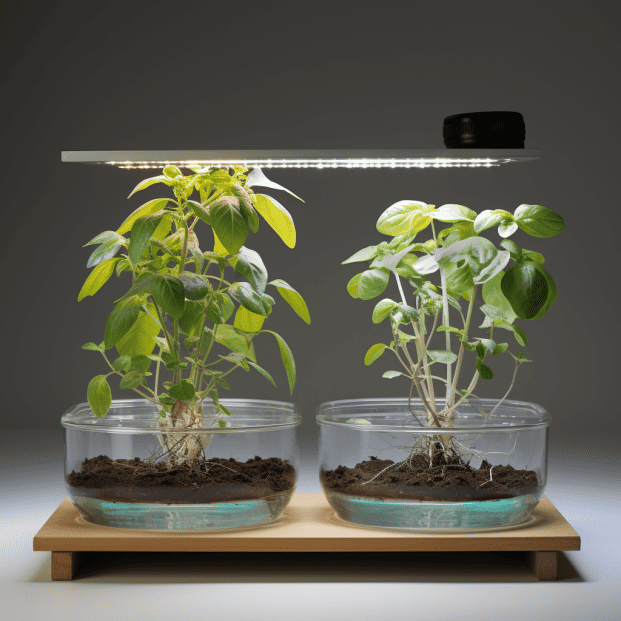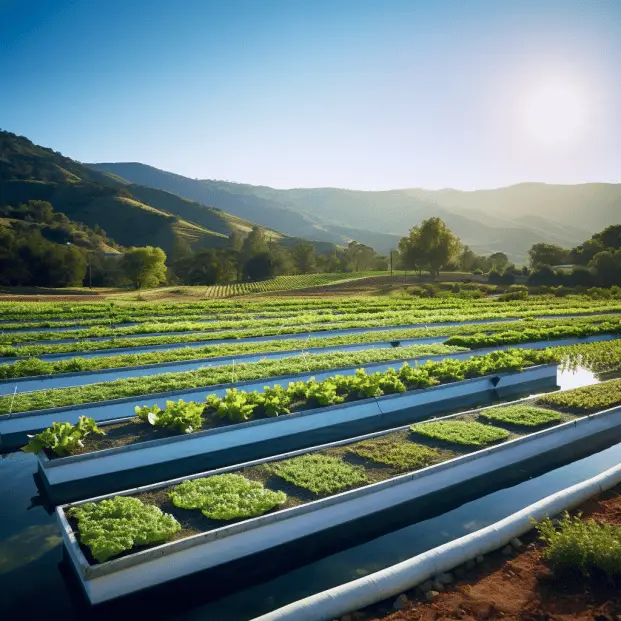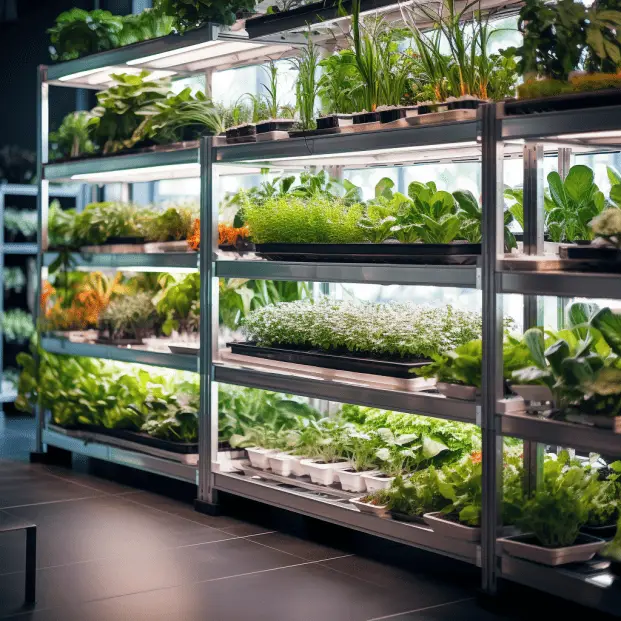Can you switch from soil to hydroponics? Absolutely! But it’s not quite as simple as just plopping your soil-grown plants into a hydro system.
There are a few key considerations to ensure your plants thrive in their new environment.
As an avid gardener who’s made the soil to hydro transition many times, let me walk you through the process step-by-step.
I’ve learned the hard way that you can’t just stick a tomato plant in water and expect it to flourish! Proper preparation is key.
First, a bad gardening joke – What do you call an alligator in a vest? An investigator! Okay, now let’s dig into the details.
By the end of this guide, you’ll be equipped with the know-how to successfully shift your crops from soil to water.
I’ll share tips to select the right system, gently wash roots, monitor nutrients, and support healthy plant growth through the transition.
So grab your gardening gloves and get ready to join me down the rabbit hole of hydroponics! Don’t worry, I’ll hold your hand each step of the way.
You’ll quickly find that hydro isn’t so scary once you understand a few basic principles.
Let’s get growing!
KEY TAKEAWAY
Can you switch from soil to hydroponics?
You can successfully switch from traditional soil gardening to hydroponics (1) by learning about the necessary adjustments in watering, nutrients, and environment.
It’s a transformative journey that offers efficient growth and resource utilization.
Is Transitioning to Hydroponics Possible?
If you’re an avid gardener used to growing plants in soil, you may be wondering – can I transition my gardens to a hydroponic system?
The short answer is yes, it is absolutely possible to switch your plants from soil to hydroponics if done carefully! (2)
As an experienced gardener who has transitioned my own plants to hydroponic systems many times, I can assure you the change is very doable.
However, it does require following some important steps when moving your plants to the new water-based environment.
There are considerations regarding plant size, washing the roots, providing support, and monitoring the transplant process.
In this guide, I’ll share my proven process for transitioning soil-grown plants of all sizes to thrive in hydroponics.
You’ll learn tips like slowly acclimating roots, preventing shock by maintaining nutrient levels, and how to select the right hydro system for your garden size.
By the end, you’ll feel confident you can successfully shift your plants into this innovative growing method.
Let’s dive in and explore how satisfying it can be to transplant your lush gardens into a meticulously controlled hydroponic environment.
With the proper steps I’ll outline, you can expect your plants to flourish as never before! The benefits of faster growth, higher yields, and healthier plants await.
Step-by-Step Guide for Switching to Hydroponics

Ready to take the plunge and transition your soil gardens into a futuristic hydroponic system? It’s an exciting journey!
With the right preparation and care, your plants will thrive in their new water-based home.
Here is a step-by-step guide to successfully switch from soil:
Start seeds or seedlings in soil as usual.
Mature transplants with an established root system adapt better than brand new seedlings.
Aim for plants around 4-6 weeks old.
Thoroughly wash soil from roots to prevent contaminating the hydro system.
Gently rinse away all traces of dirt.
Trim any bound or tangled roots.
Slowly acclimate washed roots in a container of pH-balanced water for 1-2 weeks before transferring to the hydro system, changing the water daily.
Select a hydro system that provides adequate support, like clay pebbles, for the plant’s roots to stabilize and adapt.
Gradually reduce nutrient levels to match hydroponic concentrations.
Sudden changes in nutrients can shock plants.
Closely monitor plants for signs of stress like drooping or yellowing leaves.
Adjust lighting, nutrients, and pH accordingly.
With this gradual transition process, your plants’ roots will adapt to water and your hydroponic garden will be thriving in no time!
Benefits and Challenges of Moving to Hydroponics

Transitioning plants from a soil environment to a hydroponic system comes with both benefits and challenges.
As an experienced hydroponic grower, I’ve helped many outdoor gardeners make the switch to water-based growing.
It can be done successfully! However, there are some key considerations.
The main benefits of switching to hydroponics include:
- Faster growth rates – Plants tend to grow up to 25% faster with their roots constantly immersed in nutrient solutions.
- Higher yields – You can grow more plants in less space. Hydroponics offers higher density planting.
- Less pest issues – The controlled indoor hydro environment suffers fewer pest infestations compared to outdoor soil gardens.
- Lower water usage – Hydroponics recycles and reuses nutrient solutions, resulting in 90% less water usage than soil farming.
However, there are also some challenges to consider:
- Higher startup costs – Purchasing hydroponic systems and equipment carries more upfront expense than soil gardening.
- Learning curve – It takes time to learn how to tweak and maintain optimal nutrient levels, pH, lighting, etc.
- Risk of transplant shock – Switching growing mediums can stress plant roots if not done gradually.
- No room for error – In soil, mistakes are more forgiving. Hydroponics offers less of a buffer.
By following the tips in this guide, you can minimize challenges and reap all the rewards of big, beautiful hydroponically grown plants!
Overcoming Transplant Shock: Tips and Tricks
When switching plants from soil to hydroponics, one major hurdle is the risk of transplant shock.
The change in environment can stress roots and stunt growth if not handled properly.
Luckily there are some key tricks to overcome shock during the transition:
- Start with plants that are at least 4-6 weeks old and have an established root system. This reduces shock.
- Carefully wash all soil from roots before transferring to prevent root rot or other diseases.
- Place washed roots in pH-balanced water for 1-2 weeks, slowly changing them to a water-based environment.
- Maintain consistent nutrient levels throughout the switch to prevent shocking plant roots.
- Provide support for plant roots using mediums like clay pebbles until they adapt to no soil.
- Closely monitor for signs of shock like drooping leaves and stunted growth. Adjust light and water levels accordingly.
- Some plants like tomatoes or potting mix seedlings adapt better than species prone to transplant shock like peppers or eggplant.
Take it slow and steady.
With this gentle acclimation process, your plants can transition to water-based hydroponic systems with minimal disruption to their growth and health.
The rewards of thriving hydroponic gardens await!
Choosing the Right Hydroponic System for You
When transitioning your plants from soil to hydroponics, selecting the right system for your needs is key.
As an experienced hydro grower, here are my top tips for choosing a setup:
- Consider the size of your current soil garden and number of plants. Larger gardens may need a bigger reservoir and more spacious system.
- Think about your budget. Basic hydroponic setups like Deep Water Culture are more affordable, while complex systems can cost more.
- Factor in your growing expertise – novice growers may want a more forgiving starter system vs experienced gardeners.
- Determine the level of maintenance you’re comfortable with. Some systems require more pH monitoring and nutrient management.
- Research what systems are best for the plant varieties you want to grow, like leafy greens vs tomatoes.
- Ensure adequate lighting capabilities for the number of plants you intend to transplant.
- Pick a system that allows monitoring of roots and offers support like clay pebbles during the transition from soil.
By considering these key factors, you can select the ideal hydroponic setup for successfully shifting your soil gardens into an optimal water-based growing environment.
Planting Tips for Successful Soil-to-Hydroponics Transition
Preparing your plants properly before transplanting them from soil to hydroponics is crucial. Here are some of my top planting tips:
- Start plants from seed or as young seedlings in traditional soil first to allow healthy root growth before transitioning.
- 4-6 weeks old is ideal. Avoid moving fragile seedlings with unestablished roots.
- Thoroughly wash away all soil from roots to prevent contaminating your hydro system and spreading disease. Be gentle.
- Slowly acclimate cleaned roots in pH-balanced water for 1-2 weeks before transferring to the hydro system. Change water daily.
- Provide a growing medium like clay pebbles in the hydro system to support and stabilize roots, preventing stunted growth.
- Reduce nutrient levels gradually over a few weeks when switching to prevent shocking plant roots.
- Closely monitor for signs of stress like wilt and adjust water or nutrients accordingly.
Take it slow and steady. With this careful process, your plants can transition from soil to water-based growing with minimal disruption to their health.
Exploring Hydroponic Plants That Thrive in Soil Transition
Growing plants can seem daunting without a backyard.
However, many plants thrive just as well with their roots in a soilless medium.
Certain plants that develop extensive root systems in soil may surprise you by adapting well to a hydroponic environment.
As an apartment gardener with limited indoor space, I was curious how some of my favorite veggies would take to a more controlled hydroponic setup.
With some research and experimenting over the past couple of months, I’ve identified a few plants that make for a smooth transition from soil to a humid hydroponic environment.
One herb in particular stands out – mint.
Known for its invasive root system in garden beds, mint seems to love the confined space of a small pot just as much.
All it takes is a standard four-inch plastic pot, some loose potting soil or a soilless mix, and plenty of sunlight on a window sill.
Within weeks, the mint sends out runners and fills the pot with fresh greenery.
Cut what you need to add to water or tea, and it just keeps growing back without issues.
The extensive mint roots also do well suspended in a nutrient solution.
For a simple hydroponic setup on my kitchen counter, I fill a clear container with an inch or two of growing stones or perlite.
The mint cutting goes in the middle, and I top it off with water and a mix of fertilizers.
Keeping the solution topped up and the humid environment allows the mint to thrive with inches of space below for its below-ground growth.
Commercial growers also use this method at larger scales with excellent harvests.
Tomatoes prove another winner in transitioning plant.
In soil outside, tomatoes develop sizable root balls but remain manageable in containers once established.
As fragile seedlings, they need time in smaller pots to gain size before the bigger transition.
But come mating season, a tomato plant rewards you with an abundance of fruits whether its roots know soil or a nutrient solution.
The roots take well to a hydroponic environment, and you can grow them vertically to maximize indoor space.
While some plants like broccoli prove finicky in both soil and hydroponics, many common herbs and vegetables prove more than capable of the shift.
With the right conditions, plants that normally demand outdoor gardening real estate prove they will thrive anywhere – indoors, hydroponically or in between.
Hopefully these low-maintenance options encourage more people to try small-scale home gardening regardless of their living situation or space.
Now get growing!
Maintaining a Smooth Hydroponic Transition: Key Considerations
Making the switch from soil to a hydroponic system introduces some adjustments, but focusing on a few key factors helps ensure a smooth transition for your plants.
As an avid gardener, I’ve transitioned over a dozen different varieties from traditional potting mixes to various hydroponic setups in my small apartment.
Through trial and error, I’ve learned what considerations most impact success.
The growing medium plays a big role in ease of transition.
For seedlings and smaller starts, I find coco coir to mimic soil’s properties best.
It retains moisture like soil while allowing optimal root respiration.
Larger established plants transition smoothly into expanded clay pebbles or perlite.
These porous mediums keep the root zone well-aerated and support extensive growth.
Proper nutrient levels also factor greatly.
Plants from nutrient-rich soil may struggle if hydro solutions lack similar levels initially.
Easing into recommended hydro doses prevents shock.
Monitor environmental factors even more carefully than with soil plants.
Consistent temperatures, pH levels, and moisture helproots acclimate without additional stress.
Some signs of issues may not resemble typical soil problems either.
Researching hydro-specific concerns lets you address them proactively for a smooth transition cycle.
With the right growing conditions and medium, most plants show no preference between soil or hydro once settled into their new environment.
With some care upfront, gardeners can enjoy all the perks of hydroponics.
From Soil to Hydroponics: Evaluating Feasibility and Gains
Making the switch from traditional garden soil to a hydroponic system involves evaluating if the change brings more benefits over challenges for your specific plants and situation.
As an avid gardener, I was excited to conserve space through hydroponics but wanted to be strategic which of my plants would suit it best.
Here are some factors I considered when determining feasibility and gains.
Cost proved a primary factor.
Construction materials for even simple hydroponic systems involve an initial investment versus ubiquitous potting soil.
I weighed this against long term costs like soil, fertilizers, water and electricity needs over the plant’s lifecycle.
Hydroponics reduces some costs through water and nutrient reuse.
Energizing my setup with a renewably powered air pump helps offset higher electricity costs than soil methods.
Secondly, appropriate plant selection means considering their growth habits.
Those with large, dense root bodies may struggle with the spatial confines of hydroponics whereas fast-growing vines and bushes thrive.
Smaller harvest windows for some greens also limited potential financial gains.
However, year-round production of tomatoes, peppers and salad greens in my climate more than balanced increased costs.
Ease of use ranked high as apartment space comes at a premium.
Some setups involve greatereffort to pH balance, sanitize and circulate than simply watering a potted plant.
However, drip systems and reservoirs automated much of my routine.
Overall, evaluating each plant’s needs and my priorities revealed hydroponics amplified output versus input for many of my crops.
For those interested in high yields without high-maintenance, hydroponics proves a feasible and rewarding option.
Conclusion
Now you’ve got all the tools you need to confidently switch your plants from soil to a stylish new hydroponic setup!
Remember, patience and close monitoring are key during the transition period.
But once your plants have adapted, you’ll be rewarded with faster, healthier growth.
I hope these tips have shown that shifting to hydro doesn’t have to be intimidating or risky.
Take it slow, support those roots, and let your crops ease into their new watery home.
Before you know it, you’ll have robust, thriving plants and never look back at dusty old soil again!
If you found this guide helpful, please share it with fellow gardening friends who may be curious about hydroponics.
And let me know if you have any other questions – I’m always happy to chat soil, hydro, and everything in between.
Happy growing!
References
- https://extension.umn.edu/how/small-scale-hydroponics
- https://floraflex.com/default/blog/post/a-complete-guide-to-transplanting-from-soil-to-hydroponics#:~:text=The%20first%20step%20to%20transferring,any%20part%20of%20the%20plant.
Related Articles
- https://tophydroponicgarden.com/what-is-hydroponics-2/
- https://tophydroponicgarden.com/hydroponic-plants/
- https://tophydroponicgarden.com/hydroponics-introduction/
Was this helpful?

Crystal Erickson is an agriculture enthusiast and writer with a passion for sustainable farming practices and community development. Growing up on a family farm in rural Iowa, Crystal developed a love for the land and a deep appreciation for the hard work and dedication required to make a farm successful.
After completing a degree in Agriculture and Environmental Science from Iowa State University, Crystal began her career as an agricultural journalist, covering stories and issues related to modern farming practices, crop management, and livestock production. She quickly established herself as a respected voice in the industry, known for her insightful reporting and thoughtful analysis.
Over the years, Crystal has written for a variety of publications, including Farm Journal, Successful Farming, and Modern Farmer, as well as contributing to several academic journals focused on sustainable agriculture and community development. Her work has been recognized with numerous awards, including the Iowa Farm Bureau’s Young Farmer Achievement Award and the National Association of Farm Broadcasting’s Farm Broadcaster of the Year.


